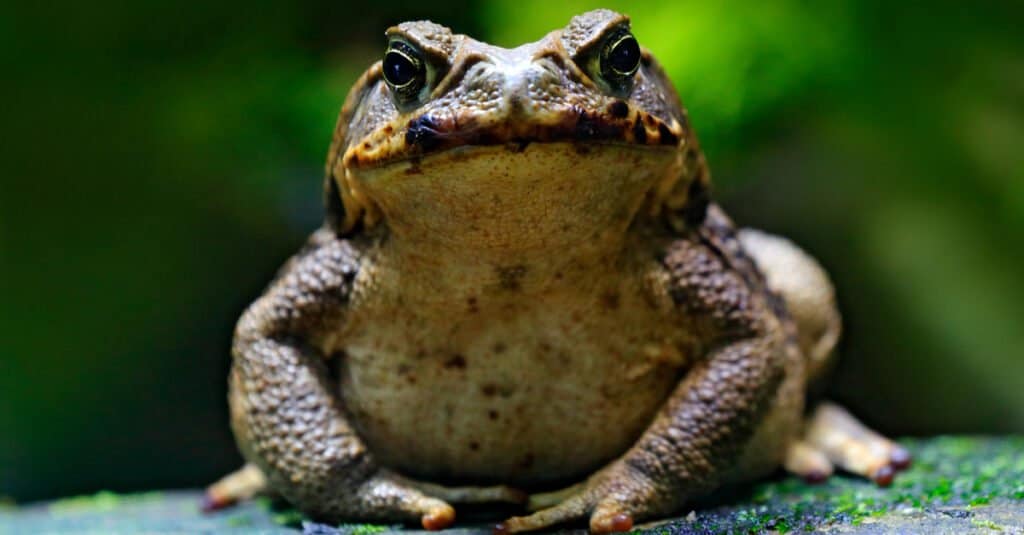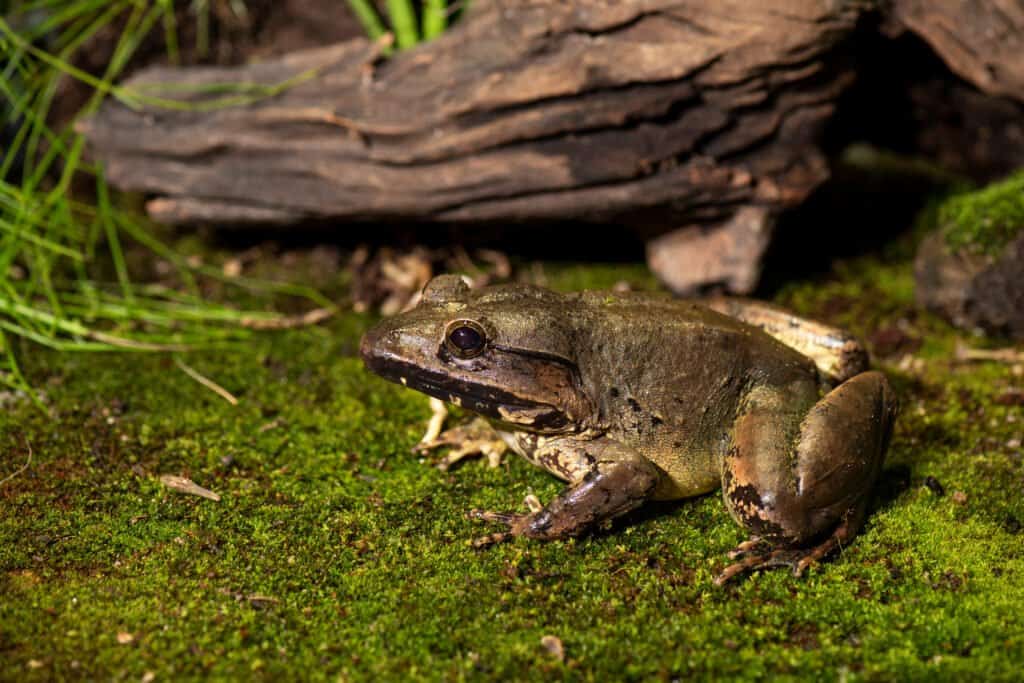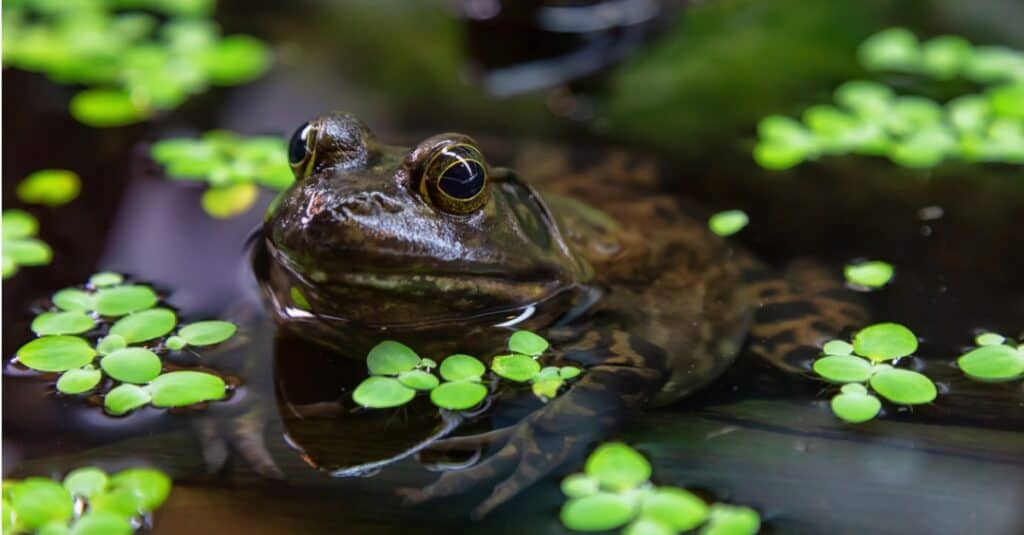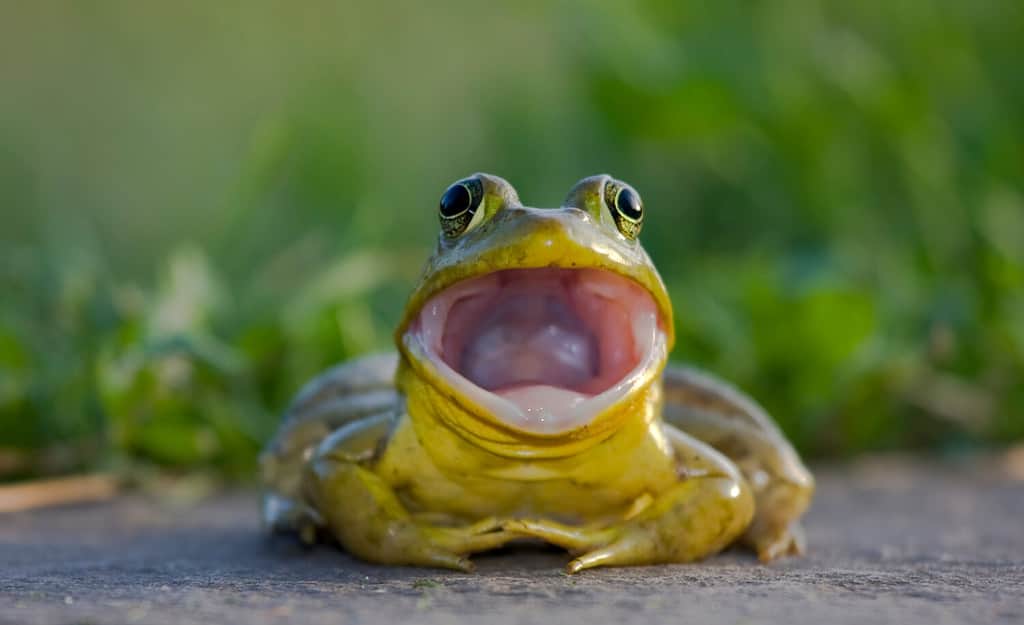There are plenty of reasons why you might want to know how to keep frogs away from your garden, pool, or yard in general. Their burrows and nests can be destructive, they’re toxic to many pets, and worst of all, they can attract snakes and other pests. Thankfully, there are plenty of methods to deter them from taking up residence in your yard as safely and humanely as possible!
Let’s go over some of the most effective ways you can keep these common amphibious pests away from your home below.
Why Keep Frogs Out of Your Yard?

Frogs and toads can be damaging to lawns and gardens, especially when they gather in large numbers.
©Ondrej Prosicky/Shutterstock.com
There are several reasons why it’s a good idea to keep frogs away from your yard. Frogs tend to congregate in large numbers, which can be unappealing to look at as well as destructive to gardens and lawns. Certain species are also toxic to many common pets like dogs and cats or even curious children. Frogs also attract lots of other yard pests like snakes and insects. These pests can do even more damage to lawns, gardens, buildings, and other structures on your property.
Most people who are particular about their yards aim to keep animals and destructive pests in general as far away as possible and for many good reasons. Perhaps you want a pristine lawn, and a colony of frogs keeps tearing it up. Maybe you have dogs that eat anything they come across, and you don’t want a toxic frog to be their next meal. You might just want to avoid attracting other, even more destructive animals to your yard.
No matter what your reasons are, it makes sense to want to keep these wide-eyed amphibians at bay. The very presence of frogs can often indicate issues with drainage, insect infestations, or excess moisture. Maybe you just don’t like frogs and find them creepy! Either way, there are lots of creative–and thankfully humane–methods to keep them away from your yard.
Ways to Keep Frogs Away: Improving Drainage

Frogs prefer to hide in very damp, heavily forested areas.
©Chattraphas Pongcharoen/Shutterstock.com
Most species of frogs are either aquatic or semi-aquatic and need lots of moisture to breathe properly. This means they tend to gather near bodies of water or in areas with a lot of shallow groundwater. If your yard doesn’t have proper drainage, it can attract frogs in droves. Installing drainage pipes, aerating your lawn, or even digging a ditch or building a creek bed for water runoff can all improve drainage.
One of the main reasons why frogs are likely attracted to your yard is moisture–or, really, excess moisture. While plenty of water can be a good thing for most lawns, too much of it creates all kinds of problems, including the presence of frogs. Fortunately, there are many creative ways you can improve the rate at which water drains from your lawn.
If you are financially able, consider installing more efficient drainage pipes throughout your yard. This is one of the most effective ways to quickly reduce groundwater buildup, though it can be pricey. Alternatively, digging drainage ditches or building DIY creek beds at the edge of your property can also be highly effective.
If you want a more immediate solution, aeration can go a long way, too. There are many different ways to aerate your lawn, from core aeration to spike and even liquid aeration. Core aeration requires you to dig “cores” of compacted soil from your yard. Spike aeration is exactly what it sounds like–digging short spikes into your yard to improve aeration. Liquid aeration is also exactly what it says on the tin, so to speak–certain chemical products are applied directly to the lawn to break down compacted soil.
Ways to Keep Frogs Away: Repellents

Substances like vinegar and lemon juice can repel frogs, but they are also irritating to their skin.
©iStock.com/edb3_16
A common and more inexpensive method of repelling frogs is to use various types of repellents. These products are made of substances that frogs naturally don’t like the smell or taste of. Rather than harming the frogs, repellents encourage them to stay away from wherever the product is applied. These can include:
- Vinegar
- Coffee grounds
- Salt
- Lemon juice
- Baking soda
- Commercial spray products
It is important to note that most of these substances are irritating and, in large amounts, damaging to frogs’ skin. Never apply any of these products directly to frogs’ skin, eyes, etc. Some commercial spray products use certain chemicals that are especially damaging or even fatal to frogs if applied directly. Always carefully check the label on any frog-repellent products before using them.
Still, if sprayed or applied in small amounts to the perimeter of your yard, they can keep frogs and some other pests like slugs out. Just be sure to reapply them after heavy rains! Most of them will dissolve and lose their efficacy over time in water.
Ways to Keep Frogs Away: Lawn Maintenance

Make sure your yard is well-maintained to discourage frogs from hiding amongst the plant growth and clutter.
©lessysebastian/Shutterstock.com
Frogs prefer living in very moist, densely forested areas to hide from predators. Keeping your lawn well-maintained will go a long way in keeping frogs away from your yard. Mow your lawn regularly, keep any large plants and shrubs trimmed, and keep clutter-like lawn decorations to a minimum wherever possible for best results.
For the most part, the only time you’ll find frogs out in the open is when it’s raining or at night when the humidity in the air is higher than usual. Otherwise, they mostly stay hidden! Some of their preferred hiding spots include trees, bushes, underneath rocks and logs, and areas with a lot of moss.
You can cut down on the number of hiding places for frogs by keeping your lawn trimmed, mowed, and generally well-manicured. If you have a lot of lawn decorations, consider getting rid of some of the ones that provide lots of nooks and crannies for frogs to climb in. Additionally, keep weed growth in your garden to a minimum and make sure any decorative plants are pruned regularly.
Certain structures like storage sheds can also shelter frogs. Areas underneath sheds, fountains, and gazebos are naturally very moist. Make sure any plants growing around or underneath any buildings and structures are also trimmed often.
Is It Good To Have Frogs Around Your House?

Yes, they’re not the best singers around. But frogs are good at keeping the insect population down.
©Tau5/Shutterstock.com
Some folks are intent on getting rid of those pesky croakers, no matter what benefits they may bring. While we’ve taken a look at the cons of having frogs around, there’s a compelling reason to leave them be–their pest control abilities.
While you may see frogs and toads as pests, they can help to keep the insect population down in your yard. Just one frog or toad can consume as many as 1,000 insects in a season. What’s more, they consume insects that are potentially harmful to humans, including fire ants, flies, termites, and mosquitos.
Other insects and animals you may not want lurking about that they consume include:
- Fruit flies
- Beetles
- Crickets
- Grasshoppers
- Spiders
- Rodents
So before you decide to drive all the frogs and toads away from your property, maybe it’s good to take stock of how beneficial they can be.
The photo featured at the top of this post is © Ondrej Prosicky/Shutterstock.com
Thank you for reading! Have some feedback for us? Contact the AZ Animals editorial team.






